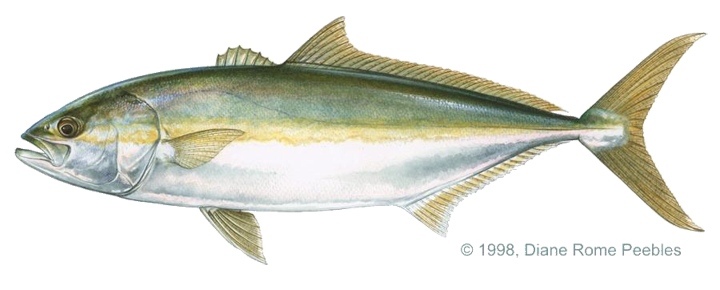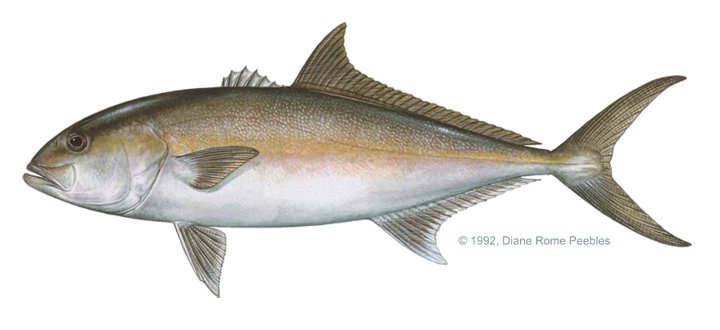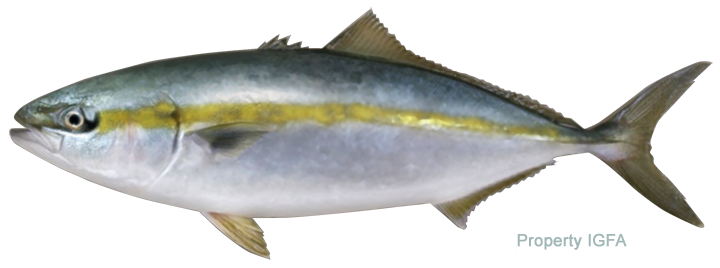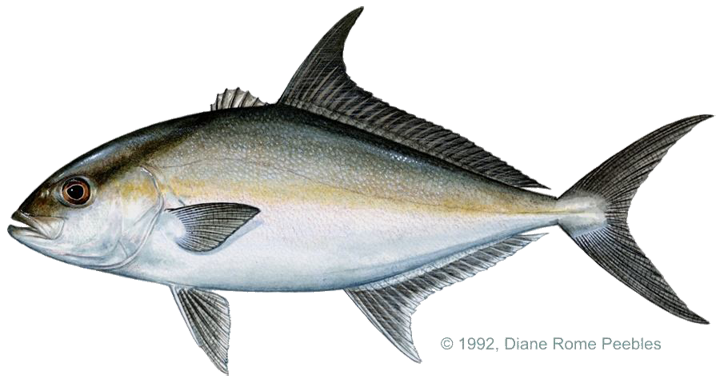Game Fish Identification Reference Guides
Yellowtail, southern
(Seriola lalandi)
(Seriola lalandi)

Cuvier & Valenciennes, 1833; CARANGIDAE FAMILY; also called yellowtail kingfish, king yellowtail, northern kingfish, Cape yellowtail, amberfish, halfkoort
Occurs south of the equator (not in equatorial waters) off Argentina, southern Brazil, St. Helena, South Africa, Australia and North Island, New Zealand. North of the equator the southern yellowtail is replaced by the California yellowtail, Seriola lalandi dorsalis (Gill, 1863) and the Asian yellowtail, Seriola lalandi aureovittata Schlegel, 1844
It is currently believed that the worldwide yellowtail complex is one species, Seriola lalandi. However, three subspecies are recognized, primarily because of their disjunct distribution and the fact that they do not interact. The subspecies are California yellowtail (Seriola lalandi dorsalis), Asian yellowtail (Seriola lalandi aureovittata), and southern yellowtail (Seriola lalandi lalandi).
The yellowtail is a coastal, schooling fish that sometimes enters estuaries. It has been reported to occur occasionally in very large schools in the Gulf of California. It feeds predominantly in the morning and late afternoon on small fishes, invertebrates, and pelagic crabs. Small to medium size fish generally undertake seasonal migrations. Larger individuals are more solitary and less migratory.
The yellowtail is easily recognized by its bright yellow tail and a characteristic brass colored stripe that runs along the median line of the flanks from the tip of the snout to the tail. It is closely related to the greater amberjack. It can be distinguished by the greater number of developed gill rakers, 21 28 on the first arch, while the amberjack has 11 16.
The yellowtail is a fast swimmer. The strike is vicious and is followed by a long, hard run and sometimes two or three shorter runs before the fish is boated. Fishing methods include trolling or casting with live baits or with lures. The yellowtail's habit of driving bait fish up against the shore makes casting from the beach possible at times. The advice of experts is to allow time for the bait to be swallowed, then strike hard.
Although opinions vary regarding the food value of this species it is generally highly regarded, with smaller specimens receiving the better ratings
Occurs south of the equator (not in equatorial waters) off Argentina, southern Brazil, St. Helena, South Africa, Australia and North Island, New Zealand. North of the equator the southern yellowtail is replaced by the California yellowtail, Seriola lalandi dorsalis (Gill, 1863) and the Asian yellowtail, Seriola lalandi aureovittata Schlegel, 1844
It is currently believed that the worldwide yellowtail complex is one species, Seriola lalandi. However, three subspecies are recognized, primarily because of their disjunct distribution and the fact that they do not interact. The subspecies are California yellowtail (Seriola lalandi dorsalis), Asian yellowtail (Seriola lalandi aureovittata), and southern yellowtail (Seriola lalandi lalandi).
The yellowtail is a coastal, schooling fish that sometimes enters estuaries. It has been reported to occur occasionally in very large schools in the Gulf of California. It feeds predominantly in the morning and late afternoon on small fishes, invertebrates, and pelagic crabs. Small to medium size fish generally undertake seasonal migrations. Larger individuals are more solitary and less migratory.
The yellowtail is easily recognized by its bright yellow tail and a characteristic brass colored stripe that runs along the median line of the flanks from the tip of the snout to the tail. It is closely related to the greater amberjack. It can be distinguished by the greater number of developed gill rakers, 21 28 on the first arch, while the amberjack has 11 16.
The yellowtail is a fast swimmer. The strike is vicious and is followed by a long, hard run and sometimes two or three shorter runs before the fish is boated. Fishing methods include trolling or casting with live baits or with lures. The yellowtail's habit of driving bait fish up against the shore makes casting from the beach possible at times. The advice of experts is to allow time for the bait to be swallowed, then strike hard.
Although opinions vary regarding the food value of this species it is generally highly regarded, with smaller specimens receiving the better ratings
















